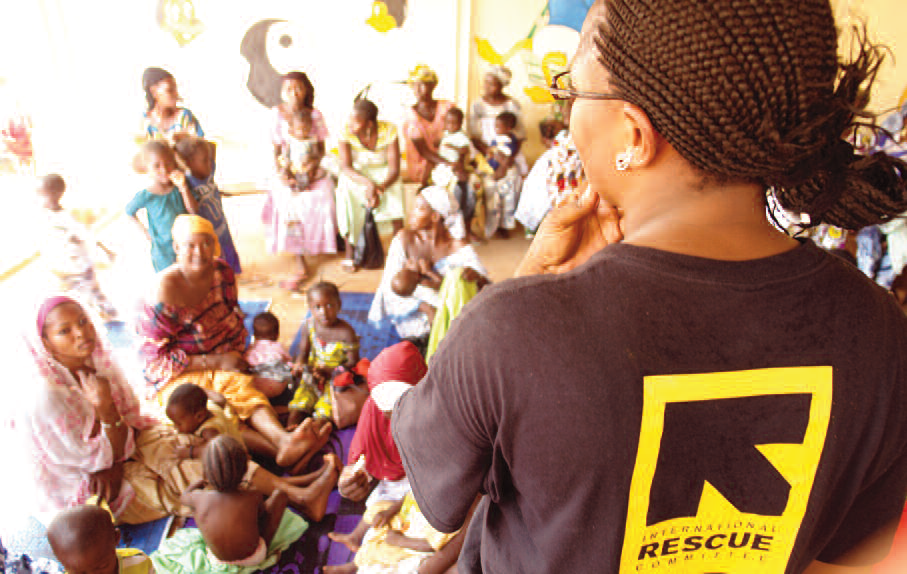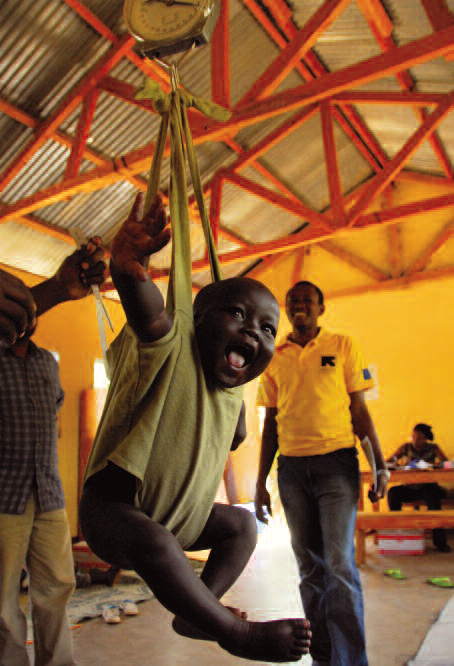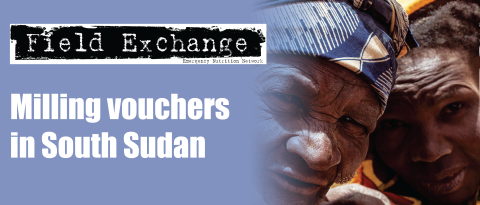Agency Profile
| Name: | International Rescue Committee (IRC) | Year founded: | 1933 |
| Address: | 122, East 42nd Street, New York, NY 10168, USA |
CEO: | David Miliband |
| Phone: | + 1 212 551 3000 | No. of HQ staff: | 350 |
| Email: | casie.tesfai@rescue.org jeanette.bailey@rescue.org |
No of staff worldwide: |
10,000 + 1,300 US-based volunteers |
| Website: | http://www.rescue.org/ |
 Interview by Jeremy Shoham, ENN
Interview by Jeremy Shoham, ENN
The ENN interviewed Casie Tesfai and Jeanette Bailey from the International Rescue Committee (IRC) for this issue’s agency profile slot. Casie joined IRC as a nutrition technical advisor in 2012 based in the New York office. Her professional life started as a Peace Corps volunteer in rural Niger leading to stints working for GOAL and UNICEF, mainly in West and East Africa. Jeanette was the first nutrition technical advisor to join IRC (September 2011) having worked the previous seven years for Médecins Sans Frontières, Action Contre la Faim and Save the Children in Africa, Asia and Latin America. They are both London School of Hygiene and Tropical Medicine alumni.
The IRC was set up in 1933 at the request of Albert Einstein to assist refugees fleeing from the Nazi regime. Pictures of Albert Einstein in a number of IRC offices act as a reminder of IRC origins. The plight of refugees is still a core concern of IRC although it now works with many non-refugee populations (about 22% of its caseload are refugees or displaced persons). IRC has domestic and international programmes with offices in 22 US cities and programmes in over 40 countries. Domestic programming is largely for new refugee arrivals in the US where IRC will help their re-settlement through for example, employment, medical and mental health support programmes.
 The organisation has grown enormously from the early days. For example, there are now six technical support units (Children and Youth Protection and Development, Women’s Protection and Empowerment, Economic Recovery and Development, Governance and Rights, Health and Research Evaluation and Learning). Nutrition is located in the Health unit which now has 31 staff members. Each of the six technical units has specialty teams, e.g. environmental health, health system strengthening and nutrition in the Health Unit.
The organisation has grown enormously from the early days. For example, there are now six technical support units (Children and Youth Protection and Development, Women’s Protection and Empowerment, Economic Recovery and Development, Governance and Rights, Health and Research Evaluation and Learning). Nutrition is located in the Health unit which now has 31 staff members. Each of the six technical units has specialty teams, e.g. environmental health, health system strengthening and nutrition in the Health Unit.
Around 13% of IRC’s international work is in conflict or emergency contexts, 55% in post emergency contexts and 32% in stable situations. Most of its funding is obtained from humanitarian donors such as ECHO, OFDA and CHASE (DFID) and is short-term. This is problematic in contexts where there are continuous needs and the short-term nature of funding requires a lot of administrative work that could be diverted into programming efforts with longer-term funding cycles. Jeanette acknowledged that this is a problem many agencies face working in fragile states and high vulnerability contexts. IRC is working towards obtaining more of its funding through multi-year awards.
IRC also has an Emergency Preparedness and Response Unit which aims to be deployed within 72 hours of an emergency being declared. This unit undertakes the immediate assessment and develops funding opportunities. The Unit will set up an emergency team which stays for the first three months and then hands over longer-term programming to the technical units.
IRC’s core nutrition programming is the management of acute malnutrition (mainly severe acute malnutrition (SAM)) within CMAM programming. The approach is very much to work within and strengthen government health systems. There are also increasing efforts to address prevention by linking programmes with other sectors in IRC, e.g. water, sanitation and hygiene (WASH), livelihoods and food security. In addition, IRC are turning their attention more to evidence based infant and young child feeding (IYCF) programming. Casie explained how they are looking at better ways of rolling out IYCF within health systems particularly focusing on the feasibility of breastfeeding counselling, its scalability and indicators needed to monitor outcomes. They are also looking at improved models to include complementary feeding. As it happens, an article written by Casie about an IYCF barriers assessment as part of a SQUEAC survey features in this edition of Field Exchange.
Jeanette also explained how most of the acute malnutrition treatment programmes (currently being implemented in ten countries) do not include moderate acute malnutrition (MAM) treatment (MAM treatment is only occurring in Chad, Yemen and Kenya). There is a general frustration within IRC, as well as other US international non-governmental organisations (INGOs) about the logistical challenges of providing treatment for MAM and the need to better integrate SAM and MAM programming. To address this, the IRC is working to pilot a combined protocol for the treatment of SAM and MAM, that sees acute malnutrition as a continuum condition, rather than separating treatment into Outpatient Therapeutic Programme + Supplementary Feeding Programme. The combined protocol would then discharge children into a prevention based programme, which depending on the context would be food security, livelihoods or a preventive health care package. The IRC is reaching out to academic and NGO partners to pilot a new protocol across several countries, and would welcome coordination with interested partners.
A major strength of IRC nutrition programming is that as they are implementing health programmes in 22 out of 40 countries in which they work, it is easier to rapidly scale up CMAM programming, train health workers and build capacity within health systems that are already being strengthened. It is also possible for IRC to address malnutrition multi-sectorally as the six technical units work closely together.
Casie acknowledged that there was still a lot of work to do on figuring out what does and doesn’t work in IYCF programming at scale. Both Jeanette and Casie are trying to bring in best practices from other organisations for whom they have worked. They are currently overseeing nutrition programmes in ten countries and want to consolidate programming before rolling out programmes in other countries, i.e. their philosophy is quality over quantity. With regard to CMAM programming, the priority for 2012/13 was about improving coverage and understanding barriers to this.
ENN asked both Casie and Jeanette what had been their main learning through their experience within IRC and in former agencies. Jeanette said that she had learnt new approaches for addressing the underlying causes of acute malnutrition. She also feels that agencies are too led by donors, i.e. follow the money, rather than set the agenda and get donors to fund that agenda. There are three areas which she sees as challenging but essential for the future of nutrition programming, i) the need to integrate MAM and SAM treatment programmes – MAM treatment cannot be optional, ii) the need for more multi-sectoral programming to address the underlying causes of malnutrition and iii) the need for more resilience based programmes, e.g. to link prevention with treatment.
A challenge identified by Casie was the fact that the nutrition sector is being overwhelmed with supplements for both the treatment and prevention of malnutrition and that there is an increasing tendency to engage with the private sector without clear frameworks for addressing conflict of interest. She feels that there are already commercial entities involved in the production and sale of complementary foods in a way that contravenes the Breastmilk Substitute (BMS) Marketing Code and that this is made worse by the fact that in many countries, the code is not very ‘strong’. Donors therefore have an important role to ensure that partners don’t violate the code. She fears that this is increasingly a “minority view”.
Both Jeanette and Casie feel that one of the major strengths of IRC is how it creates opportunities for both field staff to learn as well as inform HQ level staff about field realities and need. Once a year, health coordinators are convened at a meeting/workshop where there are opportunities for learning. A recent meeting in Bangkok addressed leadership issues. Country directors meet regionally and at headquarters regularly to ensure their perspective and needs are being heard. Many efforts are also made to include field colleagues in HQ meetings and strategy development.
Jeanette explained how since she arrived at IRC in Sep 2011, the priority has been getting programmes off the ground. However, the last eight months or so have seen the nutrition team moving forward on research. IRC has two epidemiologists in the Health unit so there is a lot of support. One study they are in the process of setting up involves following the growth of a cohort of children over a 3-5 year period in Turkana, northern Kenya in order to both look at the impact of periodic crisis, as well as the impact of interventions to address these crises. The baseline data will act as the control for subsequent measurements. This is a collaborative effort between Centres for Disease Prevention and Control (CDC)/ACF and IRC and funding is pending. Casie mentioned other research initiatives in the pipeline including some work on looking at the impact of cash transfers in the Sahel – IRC are looking for partners and funding.
 When asked what is different about IRC compared to other organisations they had worked in, Jeanette said that the emphasis on decentralised programming and building local capacity was a standout feature. Also, fairly unique is the fact that technical unit teams talk to each other so that programmes aren’t siloed along sectoral lines. Jeanette reminded me that although she and Casie had only arrived in the last three years, IRC have been doing nutrition work for over 40 years. What is hopefully different now is that the work is more systematic and strategic. Although the nutrition team is small (two people) it gets a lot of support from the organisation with nutrition now being a priority for IRC. She also mentioned that the new President and CEO of IRC is former UK Foreign Secretary David Miliband and that following extensive field travel to familiarise himself with IRC programming, he is supportive of growing the IRC’s nutrition work and ensuring that programming is conducted in alignment with IRC’s global portfolio.
When asked what is different about IRC compared to other organisations they had worked in, Jeanette said that the emphasis on decentralised programming and building local capacity was a standout feature. Also, fairly unique is the fact that technical unit teams talk to each other so that programmes aren’t siloed along sectoral lines. Jeanette reminded me that although she and Casie had only arrived in the last three years, IRC have been doing nutrition work for over 40 years. What is hopefully different now is that the work is more systematic and strategic. Although the nutrition team is small (two people) it gets a lot of support from the organisation with nutrition now being a priority for IRC. She also mentioned that the new President and CEO of IRC is former UK Foreign Secretary David Miliband and that following extensive field travel to familiarise himself with IRC programming, he is supportive of growing the IRC’s nutrition work and ensuring that programming is conducted in alignment with IRC’s global portfolio.
After the interview I found myself reflecting on how interesting these agency interviews are and how they do help tease out and distinguish the culture and approach of different agencies. Casie and Jeanette had done a fantastic job in articulating what is unique about IRC and what characteristics it shares with other agencies. One lasting impression from the interview was that IRC is one very professional and thoughtful outfit where nutrition is concerned and that there should be no surprises if IRC increasingly takes a leading role in shaping approaches to nutrition programming in the years to come.
1Community based management of acute malnutrition
2Semi-quantitative evaluation of access and coverage


